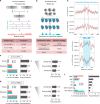Nucleosome positioning stability is a modulator of germline mutation rate variation across the human genome
- PMID: 32170069
- PMCID: PMC7070026
- DOI: 10.1038/s41467-020-15185-0
Nucleosome positioning stability is a modulator of germline mutation rate variation across the human genome
Abstract
Nucleosome organization has been suggested to affect local mutation rates in the genome. However, the lack of de novo mutation and high-resolution nucleosome data has limited the investigation of this hypothesis. Additionally, analyses using indirect mutation rate measurements have yielded contradictory and potentially confounding results. Here, we combine data on >300,000 human de novo mutations with high-resolution nucleosome maps and find substantially elevated mutation rates around translationally stable ('strong') nucleosomes. We show that the mutational mechanisms affected by strong nucleosomes are low-fidelity replication, insufficient mismatch repair and increased double-strand breaks. Strong nucleosomes preferentially locate within young SINE/LINE transposons, suggesting that when subject to increased mutation rates, transposons are then more rapidly inactivated. Depletion of strong nucleosomes in older transposons suggests frequent positioning changes during evolution. The findings have important implications for human genetics and genome evolution.
Conflict of interest statement
The authors declare no competing interests.
Figures






Similar articles
-
Somatic and Germline Mutation Periodicity Follow the Orientation of the DNA Minor Groove around Nucleosomes.Cell. 2018 Nov 1;175(4):1074-1087.e18. doi: 10.1016/j.cell.2018.10.004. Cell. 2018. PMID: 30388444
-
Increasing Nucleosome Occupancy Is Correlated with an Increasing Mutation Rate so Long as DNA Repair Machinery Is Intact.PLoS One. 2015 Aug 26;10(8):e0136574. doi: 10.1371/journal.pone.0136574. eCollection 2015. PLoS One. 2015. PMID: 26308346 Free PMC article.
-
Heterogeneous polymerase fidelity and mismatch repair bias genome variation and composition.Genome Res. 2014 Nov;24(11):1751-64. doi: 10.1101/gr.178335.114. Epub 2014 Sep 12. Genome Res. 2014. PMID: 25217194 Free PMC article.
-
Local Determinants of the Mutational Landscape of the Human Genome.Cell. 2019 Mar 21;177(1):101-114. doi: 10.1016/j.cell.2019.02.051. Cell. 2019. PMID: 30901533 Review.
-
Determinants of mutation rate variation in the human germline.Annu Rev Genomics Hum Genet. 2014;15:47-70. doi: 10.1146/annurev-genom-031714-125740. Epub 2014 Jun 5. Annu Rev Genomics Hum Genet. 2014. PMID: 25000986 Review.
Cited by
-
NucPosDB: a database of nucleosome positioning in vivo and nucleosomics of cell-free DNA.Chromosoma. 2022 Jun;131(1-2):19-28. doi: 10.1007/s00412-021-00766-9. Epub 2022 Jan 21. Chromosoma. 2022. PMID: 35061087 Free PMC article.
-
De novo mutations across 1,465 diverse genomes reveal mutational insights and reductions in the Amish founder population.Proc Natl Acad Sci U S A. 2020 Feb 4;117(5):2560-2569. doi: 10.1073/pnas.1902766117. Epub 2020 Jan 21. Proc Natl Acad Sci U S A. 2020. PMID: 31964835 Free PMC article.
-
Epigenetic modifications in esophageal cancer: An evolving biomarker.Front Genet. 2023 Jan 10;13:1087479. doi: 10.3389/fgene.2022.1087479. eCollection 2022. Front Genet. 2023. PMID: 36704345 Free PMC article. Review.
-
B1 SINE-binding ZFP266 impedes mouse iPSC generation through suppression of chromatin opening mediated by reprogramming factors.Nat Commun. 2023 Jan 30;14(1):488. doi: 10.1038/s41467-023-36097-9. Nat Commun. 2023. PMID: 36717582 Free PMC article.
-
The origin of human mutation in light of genomic data.Nat Rev Genet. 2021 Oct;22(10):672-686. doi: 10.1038/s41576-021-00376-2. Epub 2021 Jun 23. Nat Rev Genet. 2021. PMID: 34163020 Review.
References
Publication types
MeSH terms
Substances
Grants and funding
LinkOut - more resources
Full Text Sources

